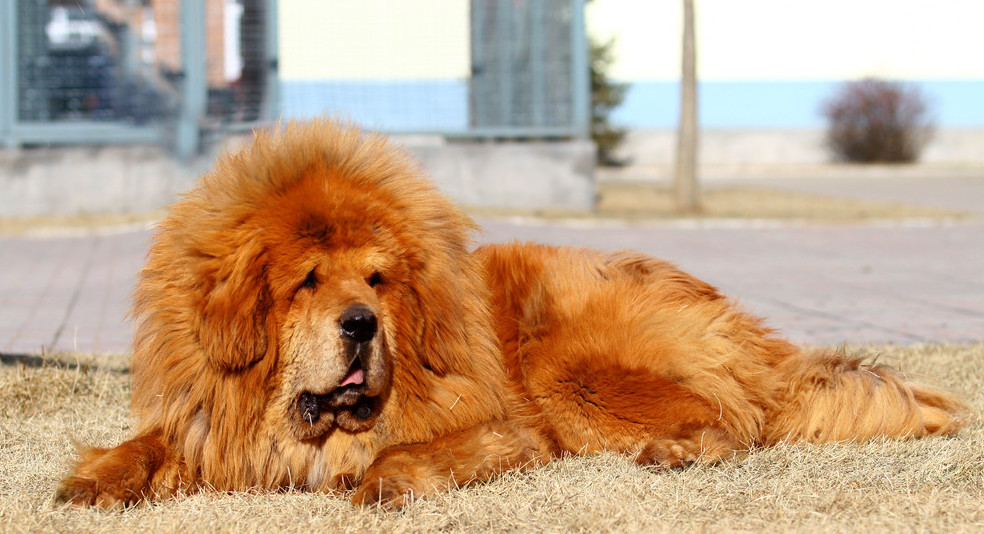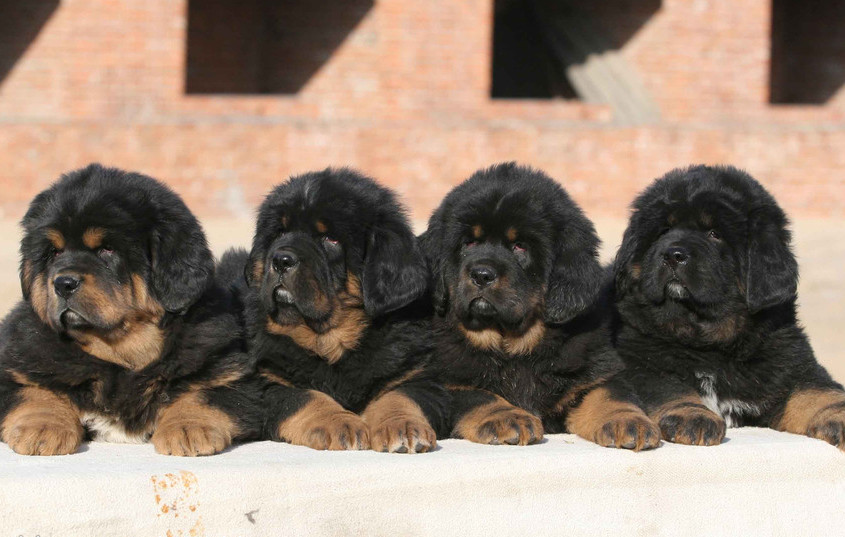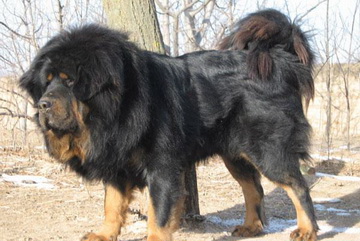Tibetan Mastiff(do-khyi)

Have you ever seen a Tibetan mastiff face-to-face? Certainly, if you've had the experience, you could hardly forget it. As a special kind of dog living on the Tibetan Plateau, these mastiffs are awesomely huge and outstandingly fierce, yet they also cooperate with human beings. Moreover, these dogs are the subject of Yang Zhijun's book, Tibetan Mastiff, a work categorized as one of this year's major releases, alongside Jia Pingwa's Qing Qiang and Yu Hua's Brothers.
Tibetan Mastiff's story takes place in the early days of the People's Republic of China. In fact, author Yang Zhijun is directly recounting the firsthand experiences of his father, when he lived on the Tibetan prairie as a journalist, alongside a mastiff named GangRiSenGe, or snow lion. Yet despite the impressive name, GangRiSenGe was an unpopular dog, and regarded as an enemy by other Tibetan mastiffs. This animosity arose since GangRiSenGe came from another pack, which had constantly been at loggerheads with the local mastiffs.
To win over other Tibetan mastiffs is not an easy thing, and Gang Ri Sen Ge had to endure numerous fights before gaining the recognition and respect of the local pack. As such, one of the interesting things about Yang Zhijun's work is the detailed analysis of these dogs' psychological behavior. Indeed, Yang depicts the Tibetan mastiffs not only as dogs but also as smart animals with their own emotional worlds. When asked how he came to understand the dogs in this way, Yang talks about the animistic beliefs that exist out on the Tibetan steppe.
"This would be called personification in literature, yet I don't believe that this is a complete explanation. Against the cultural background of Tibetan Buddhism, prairie herdsmen think in an ancient and traditional way, which is guided by religious belief, and in their eyes, all animals have intelligence. In fact, even stones, trees and the sky are regarded as living things, and since the herders can interact with these objects, they can definitely communicate with Tibetan mastiffs, which are almost like family members, shouldering various heavy burdens. Therefore, I'm just trying to see things in the way that ordinary herdsmen do, so that the Tibetan mastiff in my book is just like a human being, with a changing emotional world and psychological behavior."

As the focus of the story, GangRiSenGe, possesses all the traditional virtues of his breed, overcomes many difficulties and fights for life itself. Eventually, he manages to become the top dog among his pack and even helps bring an end to a long conflict with another mastiff gang. Yet the most impressive thing is that Tibetan mastiffs always make the safety of their human friends the first priority, whatever the circumstances. In fact, they would even be willing to die for a human, as author Yang explains:
"I believe that there's no other animal in the world like the Tibetan mastiff, possessing so many outstanding virtues. Take tigers and lions as an example. They're both powerful and formidable, similar to the Tibetan mastiff. However, unlike the mastiff, which is friendly to humans, they're not at all approachable. You can find no credibility or loyalty in them, which are exactly the qualities that the Tibetan mastiff possesses. Meanwhile, in contrast to other, overly-obedient animals, like the panda or sheep, the Tibetan mastiff always shows sufficient bravery when needed. So, its spirit can actually be regarded as an example from which we should all learn."
Actually, Yang further develops that last idea, in order to describe his dream of a better world.
"You can tell that I've placed my dreams regarding the human world upon the Tibetan mastiff. Mine is a dream of a more beautiful world, in which people become sounder in mind and body. I wish that people could possess the qualities of the Tibetan mastiff, such as loyalty, bravery, and steadfast endurance under great pressure. In today's world, we lack the moral ability to sacrifice ourselves for others, a quality which the Tibetan mastiff is born with. That is to say, the Tibetan mastiff acts to protect others out of basic instinct. Meanwhile, we're well aware that human beings could only behave in such a way after education. However, if some day in the future, people could behave in this way, and simply say, "Well, I did this because my basic instinct told me," then the world be a wonderful place. Anyway, it's only my sweet dream, a kind of naive idea, but I believe that as a writer, we do need be naive from time to time."
Sweet dreams indeed, yet Yang's book hardly paints an optimistic future for the Tibetan mastiff. Basically, the spirit of the Tibetan mastiff seems to have been weakened, so that fewer and fewer mastiffs exists which possess the original instincts of which Yang is so fond.
"I feel that the Tibetan mastiff, as a specific breed, is becoming fewer and fewer in number. Moreover, because of environmental changes, their capabilities have diminished. Take those Tibetan mastiffs from the 1950s as an example, they were so different from the current breed. At that time, danger hid everywhere and the mastiff had to remain alert at all times. Consequently they possessed a much keener sense of smell and hearing, while their fighting ability was much stronger and their movement much more agile. You could say that at that time, they had to face a fight almost everyday. However, destruction to the ecological environment, especially on the prairie, has made these animals similar to leopards and black bears, which have diminished rapidly or even become extinct. Under such circumstances, and as the Tibetan mastiff faces fewer threats, the degradation of their all-around abilities seems inevitable."
Hopefully, we can all understand Yang Zhijun's point, which he seems at great pains to stress. For Yang, it's vitally important to publicize the spirit of the Tibetan mastiff and to express regret towards the gradual loss and weakening of this particular species. However, reader He Yan tells us that she's struck by the book for may reasons, including content and language, as well as its theme. 
"Sometimes, I find myself involved in the inner world of those huge animals. In my mind, they're very lively creatures. I can also feel the strong love the author has bestowed upon those animals. Otherwise, how he could give such a wonderful description of them in his novel."
We've heard how this book examines their qualities of the Tibet mastiff and how it interacts with the local herdsmen, in a way that may remind you of Jack London's The Call of the Wild. However, there is much more to know, including the love story of Gang Ri Sen Ge, the Mastiff King, so next time you're in a bookshop, be sure to pick up a copy of Yang Zhijun's Tibetan Mastiff.
Unfortunately, no translation is yet available. However, considering the huge translation deal signed for the similarly ethnic and animal-related Wolf Totem, maybe you should still prepare yourself for a Tibetan Mastiff in your high street stores.
Tiny Encyclopedia:
1.Tibetan Mastiff, also known as "do-khyi", "home guard", "door guard", It is an ancient breed and type of domestic dog originating with nomadic cultures of Central Asia.The Tibetan Mastiff usually uses as a guardian of herds,tents, villages, monasteries, and palaces, outside the home as a guardian. They are an outstanding flock guardian and is ferocious against wolves, leopards or any prey that try to approach their flock. However, in nomad camps and in villages, the Tibetan Mastiff is traditionally allowed to run loose at night.
2.The apparance of it is large, but not a giant breed. An athletic and substantial dog, of solemn but kindly appearance. The Tibetan Mastiff stands well up on the pasterns, with strong, tight, cat feet, giving an alert appearance. The body is slightly longer than tall. The hallmarks of the breed are the head and the tail. The head is broad and impressive, with substantial back skull, the eyes deep-set and almond shaped, slightly slanted, the muzzle broad and well-padded, giving a square appearance. The typical expression of the breed is one of watchfulness. The tail and britches are well feathered and the tail is carried over the back in a single curl falling over the loin, balancing the head. The coat and heavy mane is thick, with coarse guard hair and a wooly undercoat.
3.The Tibetan Mastiff is courageous, fearless, even-tempered, calm and thoughtful. Very loyal to their own family. They have a strong desire to please their owners. They are loving with children, but can distrust and be reserved with strangers, if not properly socialized. It comes naturally to this Mastiff to guard its family and their property. They have to be raised to adulthood in a careful well-balanced manner. A stable, well-adjusted, and trained dog is for the most part generally good with non-canine pets. It is possible for them to get along with other dogs if the owners are able to communicate with them that fighting is an unwanted behavior. Tibetan Mastiffs will not listen if they sense that they are stronger minded than their owner.
4.The Tibetan Mastiff has been theorized that an early Tibetan dog is the ancestor to all Molossus breeds, although this is disputed by most experts. A highly questionable study at Nanjing Agricultural University's Laboratory of Animal Reproductive Genetics and Molecular Evolution in Nanjing, China, found that while most common dog breeds genetically diverged from the wolf approximately 42,000 years ago, the Tibetan Mastiff genetically diverged from the wolf approximately 58,000 years ago.
If you want to make a tour include the visiting to Tibetan mastiff base, please contact us at tripadvisor@chinayak.com
More Tibet tour, please click here.


